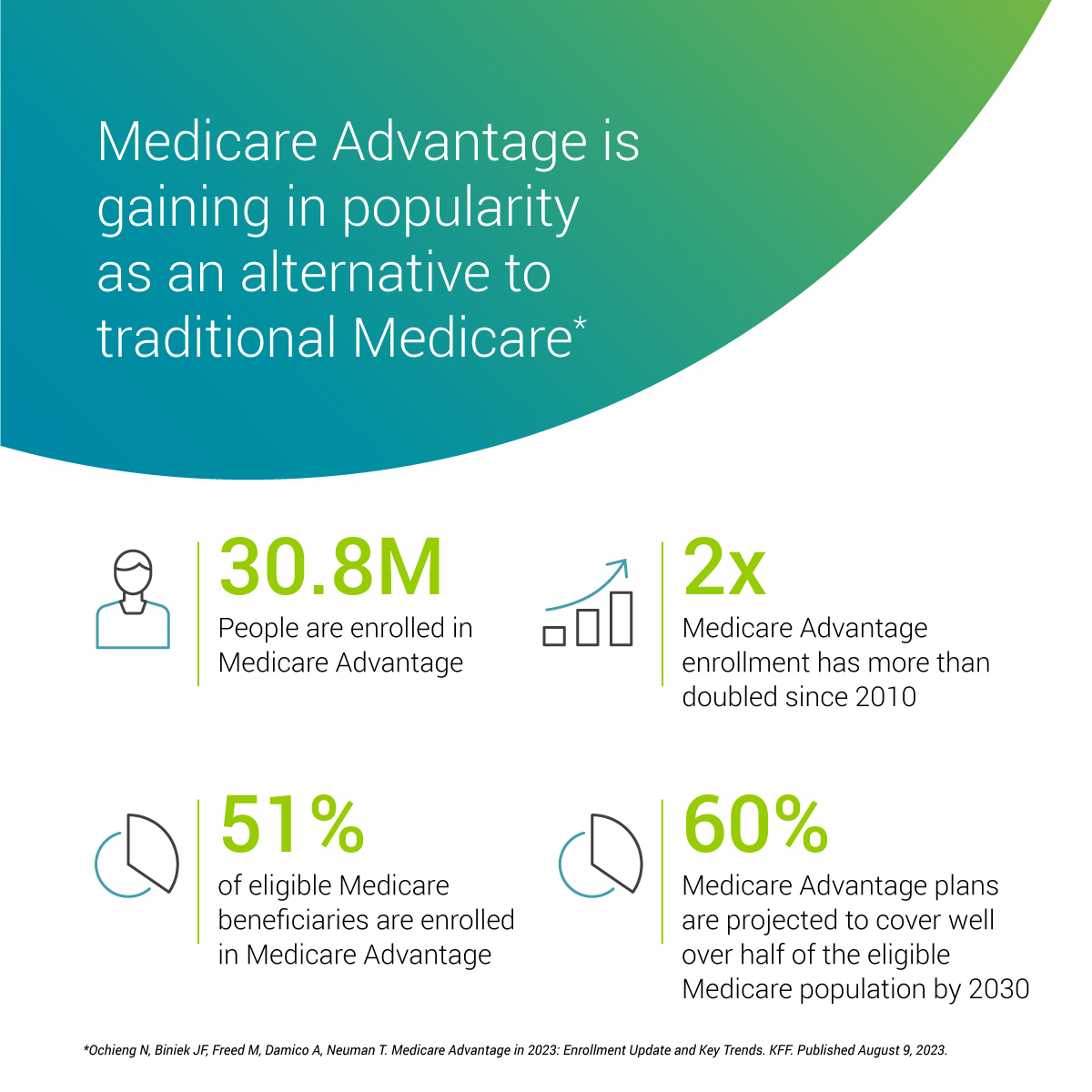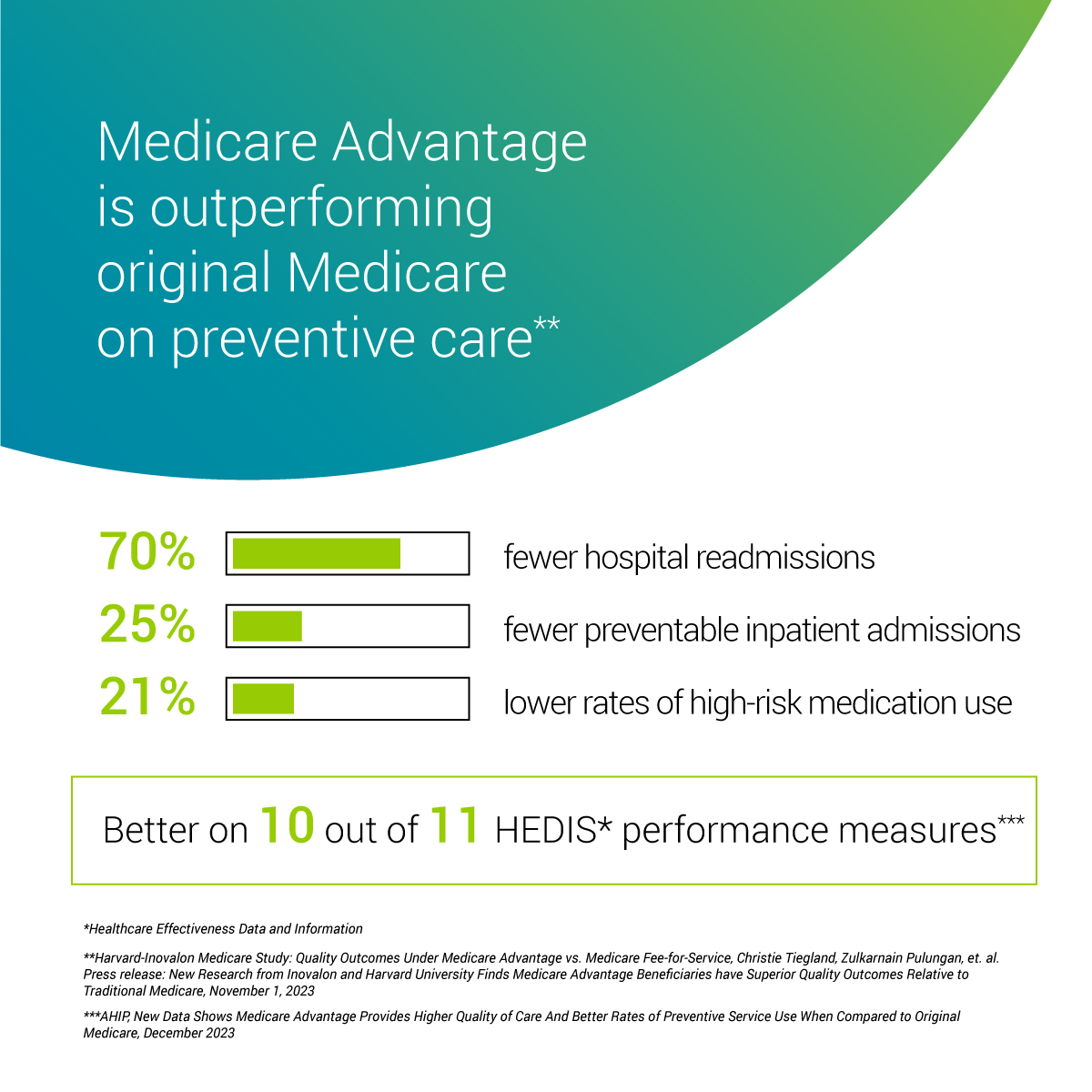
Leveraging Quality Metrics for Better Medicare Advantage Outcomes
 11 min
11 min
Today’s Medicare Advantage (MA) plans are leading healthcare’s shift away from a volume-centric approach to one that values the quality and effectiveness of care. This move aligns with the principles of value-based care (VBC) which aims to enhance patient outcomes, cost-efficiency, and the overall standard of healthcare services.
Quality ratings are becoming increasingly important in this context. They act as a benchmark for plan performance and are a decisive factor for patients choosing their MA plans, with patient satisfaction and outcome quality as key influencers.
The impact of these ratings is highlighted in a study published in Health Affairs,1 which links better patient outcomes to a one-star increase in Healthcare Effectiveness Data and Information Set (HEDIS) ratings for Medicare Advantage plans.
Key findings include:
- Admissions to higher-rated hospitals increased by 0.8 percentage points with each star increase — a 3.4% jump.
- Admissions to lower-rated hospitals decreased by 0.9 percentage points or 2.7%.
- The rate of readmissions within 90 days fell by 2.6%.
- The likelihood of patients switching away from their MA plan or to traditional Medicare dropped by 20.8%.
What this tells us is straightforward: higher-rated MA plans are delivering better care, and that translates to more stable plan enrollment and fewer hospital returns. It’s a clear indicator that quality ratings make a tangible difference in the healthcare experience.
In this blog, we’ll explore how Medicare Advantage plans can leverage quality metrics to drive better outcomes.
The Importance of Quality Metrics in Medicare Advantage
Quality metrics are what makes an MA plan stand out—they’re the quantifiable indicators of how well a plan is meeting the healthcare needs of its members. From hospital readmission rates to preventative care measures, HEDIS scores offer a granular look at the outcomes and processes of care, painting a clear picture of a plan’s effectiveness. They form the backbone of the data that MA plans analyze and strive to improve on, directly affecting the health and satisfaction of their members.
Quality metrics are intertwined with the Star Ratings system assigned by the Centers for Medicare & Medicaid Services (CMS), These ratings produce various quality metrics, including those from HEDIS, to create an overall scorecard for MA plans. Higher Star Ratings are often synonymous with superior care and enhanced patient experiences, and they’re not just a badge of honor. They carry financial implications, as higher-rated plans are eligible for bonus payments from Medicare, providing a clear incentive for plans to prioritize and improve on quality metrics.
Patient satisfaction is another critical endpoint tied to quality metrics. When patients are happy with their care—when they feel heard, treated well, and see positive health outcomes—they’re more likely to stay put with their plan. And in today’s healthcare market, patient loyalty speaks volumes.
Over time, the evolution of quality metrics has mirrored the healthcare industry’s shifting focus. What started as basic measures has developed into a sophisticated, nuanced set of indicators that reflect the complexities of patient care. As the healthcare sector has advanced, so too has the sophistication of these metrics, adapting over time to put more emphasis on the outcomes and experiences that matter most to patients. This historical shift emphasizes the critical role that quality metrics play in reflecting current standards and setting the bar for what excellent care should look like in the future.

Challenges Improving Quality Metrics
Medicare Advantage plans face significant challenges in improving quality metrics, including managing a diverse provider network, adhering to complex CMS regulations, accurately assessing member health for reimbursement, and navigating financial management under a capitated payment model.
Adopting advanced technology is key to overcome these obstacles, breaking down data silos and improving care coordination and member engagement. Streamlining processes with data analytics can also simplify compliance, risk adjustment, and financial forecasting. Proactive engagement with providers and members, alongside targeted, evidence-based interventions, can drive incremental improvements in quality metrics, discrediting the myth that only large-scale changes are effective.
Strategies for Leveraging Quality Metrics
To navigate quality metrics, MA plans must use a strategic approach to improve and showcase their performance. Key quality metrics that plans are focusing on include hospital readmission rates, the effectiveness of care, patient satisfaction scores, and adherence to preventative care guidelines.
To advance their standing in these areas, MA plans require access to real-time Admission, Discharge and Transfer (ADT) data and data analytics to identify areas for improvement. This enables them to:
Enhance patient engagement and experience:
- Send real-time alerts to providers, enabling them to proactively reach out to patients for follow-up care or health checks and provide tailored health recommendations based on insights from recent clinical data.
Implement preventative care measures:
- Identify patients due for preventative services and screenings, enabling timely interventions.
- Send automated reminders for vaccinations and routine health checks based on patient data.
Enhance transitions of care (TRC) management:
- Send clinical data directly to medical records, increasing collaboration after discharge
- Enhance follow-up care through post-discharge communication, reporting and medication reconciliation
Use data analytics to identify areas for improvement:
- Analyze ADT data to uncover patterns in readmissions and over-utilization, pinpointing areas for care enhancement.
- Leverage insights from real-time data to adjust care plans and reduce potential health risks.
Engage providers in the quality improvement journey:
- Share real-time clinical data with providers to ensure informed decision-making and care planning.
- Facilitate seamless communication between care teams for coordinated care efforts and quality improvements.
Case Scenario: Managing Chronic Conditions with Real-Time Data
Consider an MA plan seeking to improve HEDIS scores related to diabetes management. To turn this around, the plan integrates with a system that leverages real-time ADT data for more proactive care.
Here’s how the plan implements a strategy to improve outcomes:
- Real-time health data: Using real-time health data, the plan receives instant notifications when members with diabetes are admitted to or discharged from care settings. This immediate insight allows for swift coordination and adjustment of care plans.
- Proactive interventions: With access to continuous data streams, the plan identifies members frequently visiting the ER for hyperglycemic events. Case managers intervene with personalized care plans, reducing unnecessary hospitalizations and ER visits.
- Quality monitoring: Continuous monitoring ensures no patient misses critical tests or treatments. For instance, if a member misses their quarterly A1C test, the system triggers an alert, and a care manager reaches out to schedule an appointment, avoiding care gaps.
- Collaboration with providers: Providers receive real-time data and alerts about their patients’ health events, enabling them to act immediately. For example, if a patient’s blood sugar readings are irregular, their primary care physician is alerted to provide timely intervention.
- Closing care gaps: The system flags care or documentation discrepancies, prompting timely follow-up to uphold care standards and accurate coding. For instance, if a patient’s records indicate missed diabetes screenings or medication reviews, the system alerts both the case manager and the provider network, prompting immediate follow-up.
Through these measures, the MA plan achieves:
- A reduction in emergency visits related to chronic conditions.
- Increased compliance with essential health screenings.
- Improved patient satisfaction due to timely and effective care.
This approach highlights how leveraging up-to-date health data can directly improve care delivery and patient outcomes, reflecting positively in quality metrics.

Ready to Get Started?
Tackling the complexity of Medicare Advantage means embracing technologies that can keep pace with the shift toward quality-based care. That’s where PointClickCare comes into play, equipped with cutting-edge solutions designed to streamline care coordination, get providers on the same page, and enhance the health outcomes of those you serve.
Our Quality & Coding Management solution connects the dots between HEDIS measures and day-to-day healthcare delivery. It ensures your compliance game is strong and that you’re in the best position for reimbursements. This tool brings insights and action together for healthcare professionals.
With PointClickCare, plans can expect:
- Sharper insights with real-time patient updates post-discharge
- A well-managed provider network, thanks to HEDIS measures
- Enhanced TRC management and reporting
- A collaborative space where care gaps shrink, and documentation is top-notch
- Better numbers all around, from quality scores to financial performance
Discover how PointClickCare can enhance your quality metrics and streamline care coordination.
April 24, 2024





